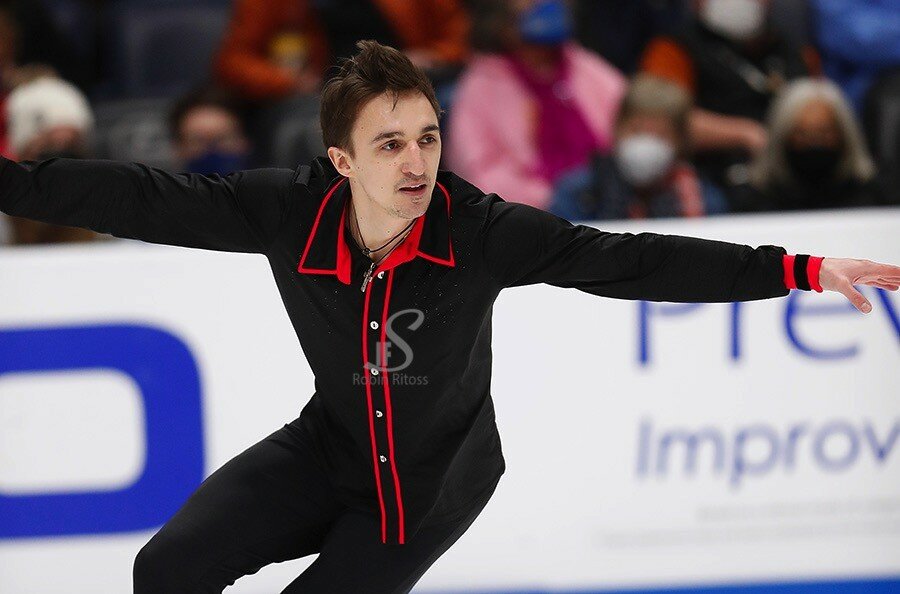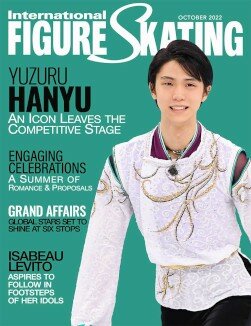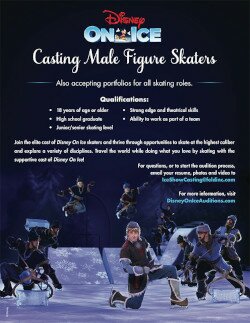
When the news broke in the fall of 2021 that Artur Dmitriev, Jr. — the eldest son of two-time Olympic pairs champion Artur Dmitriev — was switching countries and planned to represent the U.S., everyone was taken by surprise.
Dmitriev Jr. had represented his Russian homeland for almost a decade, but in late 2018 he suddenly disappeared off the skating radar. Behind the scenes he was dealing with injuries and ill health that began “a long time ago, before Sochi in 2014. I broke my leg and there was a very serious injury to the ligaments in my foot. I had to have an operation and long-term rehabilitation. After 2018, I decided to take a break,” he explained.
“The first reason was my body was tired and inside I felt I needed a rest. I worked with doctors and physiotherapists to try and regain the power I used to have. The second reason is I was changing federations. I am actually grateful for this period because I could regain the power in my body and I feel much younger than I did three years ago. So, overall, I think it worked out very good for me.”
Almost three years after his last international outing for Russia, Dmitriev switched federations to represent the United States, a country in which he had lived for seven years as a child. “When my father retired in 1998, my parents moved to the United States. He performed in shows and my mother worked as a choreographer with Sasha Cohen and Sarah Hughes. We lived here long enough to obtain citizenship. I don’t have any legal problems,” the 29-year-old said.
“I have not trained with my father since 2018 and now I work with my wife, (Ekaterina Ukolova, a former Russian figure skater he wed in August 2020). In Russia, I was not seen as a promising athlete. I received an offer from the American federation and I thought this was a good option.”
At his first event on American soil in September, Dmitriev finished third and qualified for the 2022 U.S. Championships.
Three months later, he contested his first nationals in Nashville, ranking 12th in a field of 14 in the short program. First to skate in the free, Dmitriev made a bold move by going for a quad Axel as his first jumping pass. The attempt was unsuccessful; he landed it on two feet and the jump received an under-rotation call.
“I have done better in practice,” he said in reference to the jump. “I had a landing on it four or five years ago, but I could not keep my shape up for the competition. So after three years off the ice and no competitions, I came back and tried it again. I hope soon to have a clean one. I think I am the first one to do it in competition — I don’t know anyone else before me.”
Training the quad Axel requires preparation and time said Dmitriev Jr. “I usually take 15 minutes to work on it and when I am ready I will jump it. Then I take time off and when I feel I can I will do it again.”
When asked how he started working toward mastering the quad Axel the St. Petersburg native said he first attempted two triple Axels in a row. “Then I was like, hmm…can I do three in a row? I did three in a row and then four in a row, he explained. “And then I thought, ‘what if I go for the quad Axel?’ Can I do that? Let’s try it. That is why I am trying to do it. It is like another level psychologically. It is not one foot, two feet – it is in the head.”
He admitted he had seen Yuzuru Hanyu’s quad Axel attempt at the All Japan Championships and felt he “did a good job.”
Citing his age, Dmitriev Jr. said he limits his training sessions and listens to his body. “I can take a day off randomly if my body is telling me to stop. I could even do like one hour (of training) a day and it would be fine.”
In mid-September he began training for the qualifying event, and started working on his programs – and his jumps. The following month he was still only doing triples, and had not attempted any quads. “Little by little I am gaining shape and I hope everything will be good. I have to work a lot. I have to do gym, a lot of stretching, so I think I need about half a year to get back to my full shape,” he said.
Though he is focused on mastering four revolutions, the Axel is not his favourite jump. “I like all little parts of every jump. They are all different. With the quad Axel — we started when my father coached me when I was small. We did two jumps: loop and a single Axel and he taught me the double Axel. But I love every jump.”
“I intend to return to duty. How it will turn out, we will see. I am absolutely serious.”





